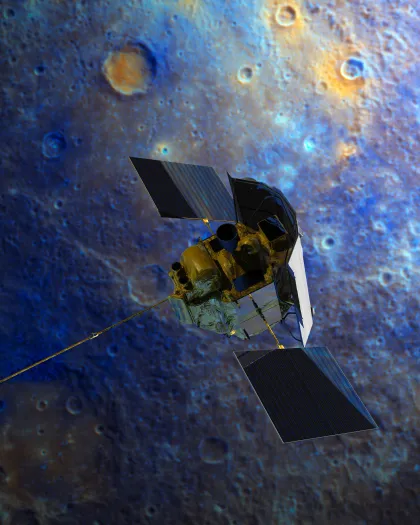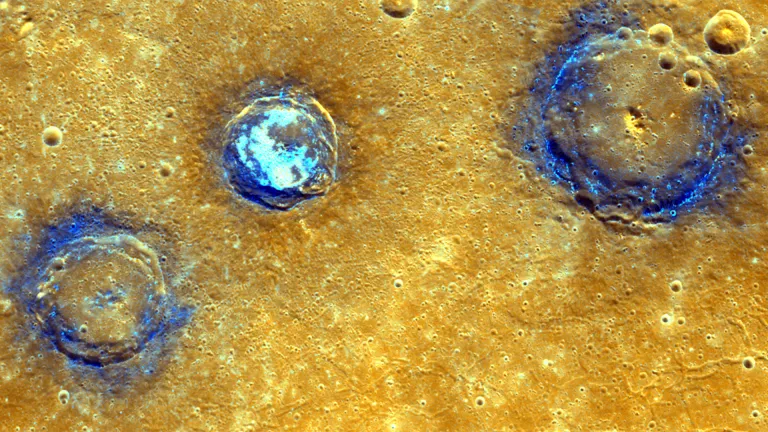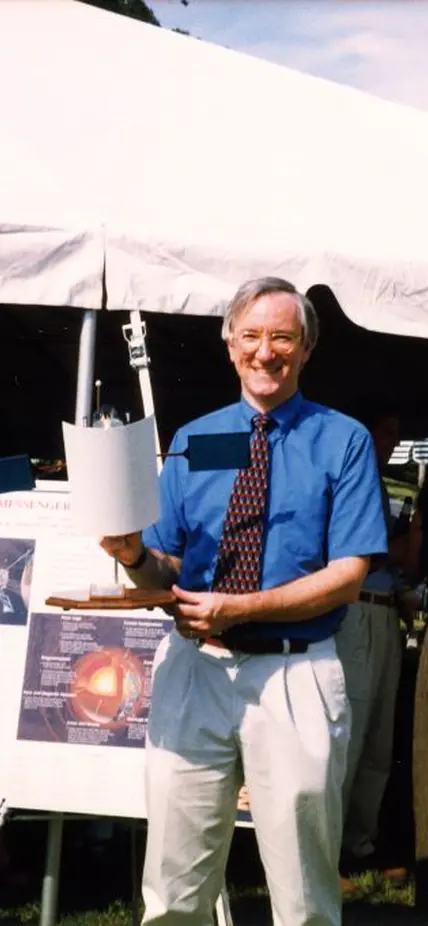
Q: As the Principal Investigator of the MESSENGER mission, what were your personal highlights or proudest moments throughout the mission's duration?
Sean Solomon: There were many personal highlights for me during the MESSENGER mission, beginning with our initial selection by NASA in 1999 and culminating in the publication by the MESSENGER science team of all of the findings from our mission in a book published nearly two decades later.
The most challenging events in any planetary orbiter mission are launch and orbit insertion. The successful completion of those two milestones for MESSENGER—in 2004 and 2011, respectively—were sources of great pride for me in the technical expertise of all of the engineers, mission design experts, and project managers who contributed to the mission.
The long flight portion of the mission provided multiple scientific highlights. MESSENGER’s first flyby of Mercury in January 2008 yielded the first new spacecraft observations of Mercury in 33 years, and our team published 11 papers in a single issue of Science from those measurements six months later. The second and third flybys yielded further new results and more journal special issues. The four years in orbit about Mercury produced a wealth of information about the innermost planet and a steady stream of discoveries.
Another highlight for me was to witness the professional growth of a number of the students, postdoctoral researchers, and early-career scientists who were part of the MESSENGER science team during at least some portion of the mission. Many of them made major contributions to the analysis and scientific interpretation of mission observations and are among the leading Mercury experts today.
Q: Can you elaborate on how Carnegie Science contributed uniquely to the success of the MESSENGER mission compared to other institutions involved?
Sean Solomon: Carnegie Science, of course, was the home of the mission’s Principal Investigator (PI), responsible not only for accomplishing the scientific objectives of the mission but also for ensuring that all schedule, financial, and data delivery milestones for the mission were met. That I could serve as a NASA mission PI while I was director of Carnegie’s Department of Terrestrial Magnetism (DTM)—now part of the institution’s Earth and Planets Laboratory—was the result of several factors. These included the flexibility of an institutional calendar without academic demands, the assistance of excellent support staff, and the proximity to DTM of the implementing organization for the design, development, and flight operation of the spacecraft—the Johns Hopkins University Applied Physics Laboratory (APL), located in Laurel, Maryland, about a 30-minute drive from the Broad Branch Road campus.

Among the Carnegie staff members who played key roles for MESSENGER are several I’d like to mention. Terry Stahl, our department’s Fiscal Officer, oversaw our contract with NASA to manage the mission’s science team, education and public outreach team, and spacecraft navigation team, as well as all of the subcontracts to partnering universities and other organizations. Janice Dunlap handled all formal correspondence with NASA, APL, science team groups, and others outside the project. Michael Acierno and Sandra Keiser managed our department’s scientific and administrative computer networks throughout the duration of the mission. Julie Edmonds, director of the Carnegie Academy for Science Education, led MESSENGER’s education and public outreach team and ensured that the mission’s goal of disseminating its technical achievements and scientific findings to educators and the public was met.
That APL—with a long record of successful space missions in Earth orbit before they started taking on deep-space missions in the 1990s—was geographically close to DTM is not an accident. APL was the creation of DTM director Merle Tuve and several of his colleagues early in World War II, when the group’s efforts to develop a proximity fuze to improve anti-aircraft defense and other military applications of advanced physics grew too large to be managed within the confines of the Broad Branch Road campus. A portrait of Tuve now hangs in APL’s Building 1, just outside the auditorium where APL hosted the NASA site visit teams that evaluated the MESSENGER mission proposal.
Also worthy of mention is Carnegie’s outstanding postdoctoral fellowship program, because several of those fellows played important roles in the MESSENGER mission. When NASA enlarged the MESSENGER science team through a call for proposals to serve as a Participating Scientist on the mission, three former Carnegie fellows were selected: Steven Hauck, who led the team’s analysis of Mercury’s geodetic parameters to infer the planet’s internal structure; Catherine Johnson, who led the team’s analysis of Mercury’s modern and ancient magnetic fields; and Larry Nittler, who led the team’s analysis of Mercury’s surface composition from X-ray fluorescence spectrometry. Larry, of course, was a member of Carnegie’s Research Staff at the time of his selection, and he later served as Deputy Principal Investigator for the mission and co-editor of the book reporting on our new understanding of Mercury at the end of the mission.
Several Carnegie postdoctoral fellows also contributed to the MESSENGER mission during or shortly after their fellowship tenure. Paul Byrne and Christian Klimczak mapped the tectonic structures of Mercury and modeled the processes that led to their formation, and Shoshana Weider spearheaded some of the later analyses of X-ray fluorescence data to map distinct geochemical terranes on Mercury. Former Geophysical Laboratory fellow Francis McCubbin and one of his students made the important prediction in 2015 that Mercury’s crust may be enriched in graphite if, like the Moon, its early state was characterized by a global magma ocean.
Q: What do you believe were the most groundbreaking discoveries made by MESSENGER, and how do they continue to impact our understanding of Mercury and planetary science today? How have these discoveries reshaped our understanding of planetary formation and evolution?
Sean Solomon: As the first Mercury orbiter mission, MESSENGER provided a global view of the Solar System’s innermost planet for the first time. MESSENGER also carried a more extensive instrument payload than Mariner 10—the only other spacecraft to have visited Mercury up to that time—and one that benefitted from more than three decades of advances in sensors, electronics, and miniaturization.

In particular, MESSENGER conducted the first geochemical remote sensing of Mercury’s surface by means of multiple sensors, including X-ray, gamma-ray, and neutron spectrometers; multispectral imaging; and ultraviolet, visible, and near-infrared spectrometry. A number of MESSENGER’s most important discoveries came from those observations.
MESSENGER documented that Mercury has a sulfur-rich, iron-poor surface, indicating that the planet formed from much more chemically reduced materials than those that formed the other inner planets and most meteorite parent bodies. That finding points to strong heterogeneity in the redox state of materials in the protoplanetary disk of dust and gas that orbited the early Sun and from which all Solar System objects were derived.
Contrary to all models advanced ahead of the MESSENGER mission to account for Mercury’s high bulk density and inferred high fraction of metal relative to silicates, MESSENGER found that Mercury is not depleted in moderately volatile elements. Instead, Mercury displays surface concentrations of K, Na, and Cl comparable with those on Mars. Moreover, MESSENGER discovered abundant geological features indicative of volatiles at depth. Hollows—irregular depressions, often with flat floors and bright halos, and best explained as having formed by loss of a volatile material from depth after exposure to Mercury’s surface conditions—are widespread on surface materials excavated by impacts. And among Mercury’s volcanic features are pyroclastic deposits, products of past explosive eruptions triggered when the erupting magmas exsolved volatiles during ascent and pressure release. Whatever processes led to Mercury’s high metal/silicate ratio, therefore, did not markedly deplete the planet of moderately volatile species relative to the other inner planets.
From MESSENGER spectral reflectance, gamma-ray, and neutron observations, Mercury’s surface contains carbon at concentrations up to a few weight percent, most likely in the form of graphite. The carbon concentrations are highest in Mercury’s darkest deposits, which were excavated during the formation of large impact craters. This finding matches the prediction that Mercury’s modern crust should contain remnants of a graphite flotation crust that formed during the cooling of an early magma ocean.

From neutron spectrometry, insolation modeling with measured topography, and visible and near-infrared reflectance, MESSENGER confirmed that Mercury’s polar deposits—discovered in the early 1990s by Earth-based radar imaging—consist predominantly of water ice, stable over geological timescales in permanently shadowed regions on the floors of the highest-latitude impact craters. Farther from the poles, water ice in polar deposits is also thermally stable on geological timescales, but only if covered by a thin insulating layer, and such a layer is indicated by neutron spectrometry. Reflectance measurements indicate that the insulating layer is darker than any other material on Mercury’s surface and has thermal stability characteristics consistent with organic materials found in comets and volatile-rich meteorites. These observations suggest that the permanently shadowed regions of Mercury’s high-latitude craters are witness plates to the delivery of water and organic ices from the outer to the inner Solar System, a process thought important to the inventory of water and prebiotic compounds on early Earth.
MESSENGER’s most noteworthy discoveries extended beyond those from geochemical remote sensing to many other aspects of the planet, its environment, and its history:
MESSENGER’s geodetic and gravity field measurements indicate that Mercury’s iron-rich core is larger than previously thought. Interior models consistent with the planet’s geodetic parameters and gravity field include a core with a radius some 80 percent of the planet’s radius.
From orbital magnetic field measurements, MESSENGER showed that Mercury has a dipolar internal magnetic field likely generated, as on Earth, by a dynamo in the planet’s fluid outer core. Unlike the fields of Earth, the outer planets, or outer planet satellites with such fields, however, Mercury’s internal dipole is offset from the planet center by about 20 percent of Mercury’s radius, a result not predicted by theoretical dynamo models prior to the MESSENGER mission.

MESSENGER observations of the distribution and geometry of Mercury’s surface tectonic features indicate that the planet’s interior cooled and contracted more than previously estimated. Importantly, estimates for such contraction since the end of heavy bombardment of the inner Solar System are now in agreement with the predictions from models for the thermal evolution of Mercury’s mantle and core.
Mercury’s tenuous neutral atmosphere—a surface-based exosphere—was shown by MESSENGER to vary seasonally with the planet’s changing solar distance over the course of a Mercury year. Moreover, the distribution by time of day differs among the most important atmospheric constituents (Na, Ca, Mg) derived from surface materials, pointing to a different mix of source processes for each, and the seasonal variation for Mg contains a signature of differences in surface Mg abundances among major geochemical terranes on the surface.
Because Mercury is much closer to the Sun than Earth and its magnetic dipole strength is weaker by three orders of magnitude, its magnetosphere is much smaller than Earth’s, and MESSENGER demonstrated that all magnetospheric phenomena operate on much shorter timescales. Mercury’s magnetosphere hosts bursts of energetic electrons but no durable radiation belts as at Earth. Notably, Mercury experiences magnetic reconnection rates much higher than at Earth and occasional collapse of the dayside magnetosphere in response to unusually strong solar wind ram pressure. Exposure of the surface to such direct solar wind impact contributes to an alteration of surface materials more rapid than on other airless or nearly airless bodies and to the generation of Mercury’s neutral atmosphere.
Q: Looking forward, how do you envision future missions to Mercury building upon the foundation laid by MESSENGER, and what key scientific questions do you hope they will address?
Sean Solomon: The next mission to Mercury is already in progress—the BepiColombo dual orbiter mission of the European Space Agency and the Japan Aerospace Exploration Agency. Although BepiColombo was conceived and selected for flight at about the same time as MESSENGER, its greater ambition and complexity and its multinational and multi-agency character led to a much longer development time. The BepiColombo spacecraft were launched in 2018 and are scheduled to be captured into orbit about Mercury late next year. Because that mission involves two spacecraft operating simultaneously, includes more instruments than MESSENGER, and will view the planet from different orbits, the observations that BepiColombo will make promise to build on and extend those of MESSENGER in multiple ways.
There are limits to what can be measured from orbit, however, and so the next NASA mission to Mercury will probably be a lander. The objectives

of a Mercury lander mission will depend on the choice of landing site, but will likely include chemical, mineralogical, and isotopic analyses of Mercury surface materials to provide ground truth to orbital remote sensing and constrain magmatic and surface geological processes and their histories; seismic and geodetic measurements to characterize tectonic and impact sources of seismicity and improve information on the planet’s internal structure; and magnetic field and energetic particle measurements to advance knowledge of Mercury’s crustal magnetic field and interactions between the magnetosphere and the surface and interior. A lander on Mercury’s polar deposits would also permit the in situ analysis of ices delivered by the impact of comets and volatile-rich asteroids from the outer Solar System, as well as important insight into the nature of volatile mixing and loss processes on Mercury’s surface.
Q: What is the importance of public outreach and education initiatives, such as the MESSENGER Education and Public Outreach Team's efforts, in engaging the broader community with space exploration missions?
Sean Solomon: Solar System exploration is funded by taxpayers, and the public deserves to be told why each such mission is worthwhile and what it has revealed about our neighboring planets as well as our own world. Moreover, space exploration is an engaging subject to audiences of any age. Students in particular are drawn to the topic, and some will be motivated by their interest in space exploration to pursue lifelong careers in science and engineering. More broadly, a technically literate public is of vital national interest, as an increasing number of topics critical to society’s future are grounded in an understanding fed by continuing scientific discovery.

Q: Lastly, what message or lesson do you hope future generations of scientists and explorers will take away from the achievements of the MESSENGER mission?
Sean Solomon: The exploration of the Solar System teaches us that the achievement of some goals requires exceptional patience and persistence. I was a young Assistant Professor when the first spacecraft mission to Mercury—Mariner 10—returned the first close-up views of that planet in the mid 1970s. Later that decade I helped write the first strategy for the scientific exploration of Mercury to follow that mission. For a variety of reasons, it took another two decades before the second mission to Mercury, MESSENGER, was selected for flight. Providing funding for and completing development of that spacecraft consumed another five years, and MESSENGER spent more than six and a half years in flight—more than 15 revolutions about the Sun—before becoming the first spacecraft to orbit Mercury. The end of MESSENGER’s orbital operations four years later came 40 years after Mariner 10 had returned its last data. We now know a great deal more about one of our nearest planetary neighbors than we did before, but the journey was long.
